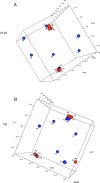Alterations of microbiota in urine from women with interstitial cystitis
- PMID: 22974186
- PMCID: PMC3538702
- DOI: 10.1186/1471-2180-12-205
Alterations of microbiota in urine from women with interstitial cystitis
Abstract
Background: Interstitial Cystitis (IC) is a chronic inflammatory condition of the bladder with unknown etiology. The aim of this study was to characterize the microbial community present in the urine from IC female patients by 454 high throughput sequencing of the 16S variable regions V1V2 and V6. The taxonomical composition, richness and diversity of the IC microbiota were determined and compared to the microbial profile of asymptomatic healthy female (HF) urine.
Results: The composition and distribution of bacterial sequences differed between the urine microbiota of IC patients and HFs. Reduced sequence richness and diversity were found in IC patient urine, and a significant difference in the community structure of IC urine in relation to HF urine was observed. More than 90% of the IC sequence reads were identified as belonging to the bacterial genus Lactobacillus, a marked increase compared to 60% in HF urine.
Conclusion: The 16S rDNA sequence data demonstrates a shift in the composition of the bacterial community in IC urine. The reduced microbial diversity and richness is accompanied by a higher abundance of the bacterial genus Lactobacillus, compared to HF urine. This study demonstrates that high throughput sequencing analysis of urine microbiota in IC patients is a powerful tool towards a better understanding of this enigmatic disease.
Figures




Similar articles
-
Assessing diversity of the female urine microbiota by high throughput sequencing of 16S rDNA amplicons.BMC Microbiol. 2011 Nov 2;11:244. doi: 10.1186/1471-2180-11-244. BMC Microbiol. 2011. PMID: 22047020 Free PMC article.
-
The bacterial microbiota of Hunner lesion interstitial cystitis/bladder pain syndrome.BJU Int. 2022 Jan;129(1):104-112. doi: 10.1111/bju.15519. Epub 2021 Jul 5. BJU Int. 2022. PMID: 34143561
-
Stool-based biomarkers of interstitial cystitis/bladder pain syndrome.Sci Rep. 2016 May 18;6:26083. doi: 10.1038/srep26083. Sci Rep. 2016. PMID: 27188581 Free PMC article.
-
Diversity of the autochthonous colonic microbiota.Gut Microbes. 2011 Mar-Apr;2(2):99-104. doi: 10.4161/gmic.2.2.15416. Gut Microbes. 2011. PMID: 21694499 Free PMC article. Review.
-
The Urinary Microbiome in Interstitial Cystitis/Bladder Pain Syndrome? A Critical Look at the Evidence.J Urol. 2021 Nov;206(5):1087-1090. doi: 10.1097/JU.0000000000001947. Epub 2021 Jun 29. J Urol. 2021. PMID: 34184928 Review. No abstract available.
Cited by
-
Microbiota—implications for immunity and transplantation.Nat Rev Nephrol. 2015 Jun;11(6):342-53. doi: 10.1038/nrneph.2015.70. Epub 2015 May 12. Nat Rev Nephrol. 2015. PMID: 25963591 Review.
-
Optimizing bacterial DNA extraction in urine.PLoS One. 2019 Sep 24;14(9):e0222962. doi: 10.1371/journal.pone.0222962. eCollection 2019. PLoS One. 2019. PMID: 31550285 Free PMC article.
-
Benchmarking urine storage and collection conditions for evaluating the female urinary microbiome.Sci Rep. 2019 Sep 16;9(1):13409. doi: 10.1038/s41598-019-49823-5. Sci Rep. 2019. PMID: 31527753 Free PMC article.
-
Alpha-diversity and microbial community structure of the male urinary microbiota depend on urine sampling method.Sci Rep. 2021 Dec 9;11(1):23758. doi: 10.1038/s41598-021-03292-x. Sci Rep. 2021. PMID: 34887510 Free PMC article.
-
The Potential Role of Urinary Microbiome in Benign Prostate Hyperplasia/Lower Urinary Tract Symptoms.Diagnostics (Basel). 2022 Aug 1;12(8):1862. doi: 10.3390/diagnostics12081862. Diagnostics (Basel). 2022. PMID: 36010213 Free PMC article. Review.
References
-
- Abrams P, Cardozo L, Fall M, Griffiths D, Rosier P, Ulmsten U, van Kerrebroeck P, Victor A, Wein A. The standardisation of terminology of lower urinary tract function: report from the Standardisation Sub-committee of the International Continence Society. Neurourol Urodyn. 2002;21(2):167–178. doi: 10.1002/nau.10052. - DOI - PubMed
-
- Hanno PM. Diagnosis of interstitial cystitis. Urol Clin North Am. 1994;21(1):63–66. - PubMed
Publication types
MeSH terms
Substances
LinkOut - more resources
Full Text Sources
Other Literature Sources
Medical
Research Materials
Miscellaneous

